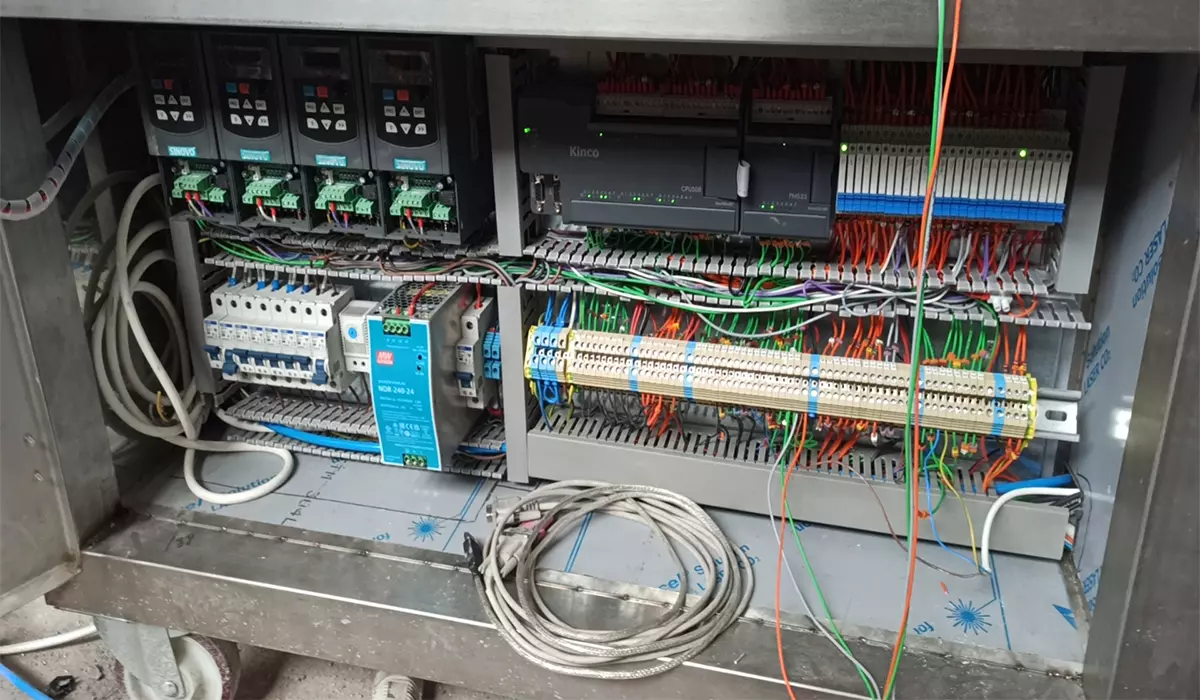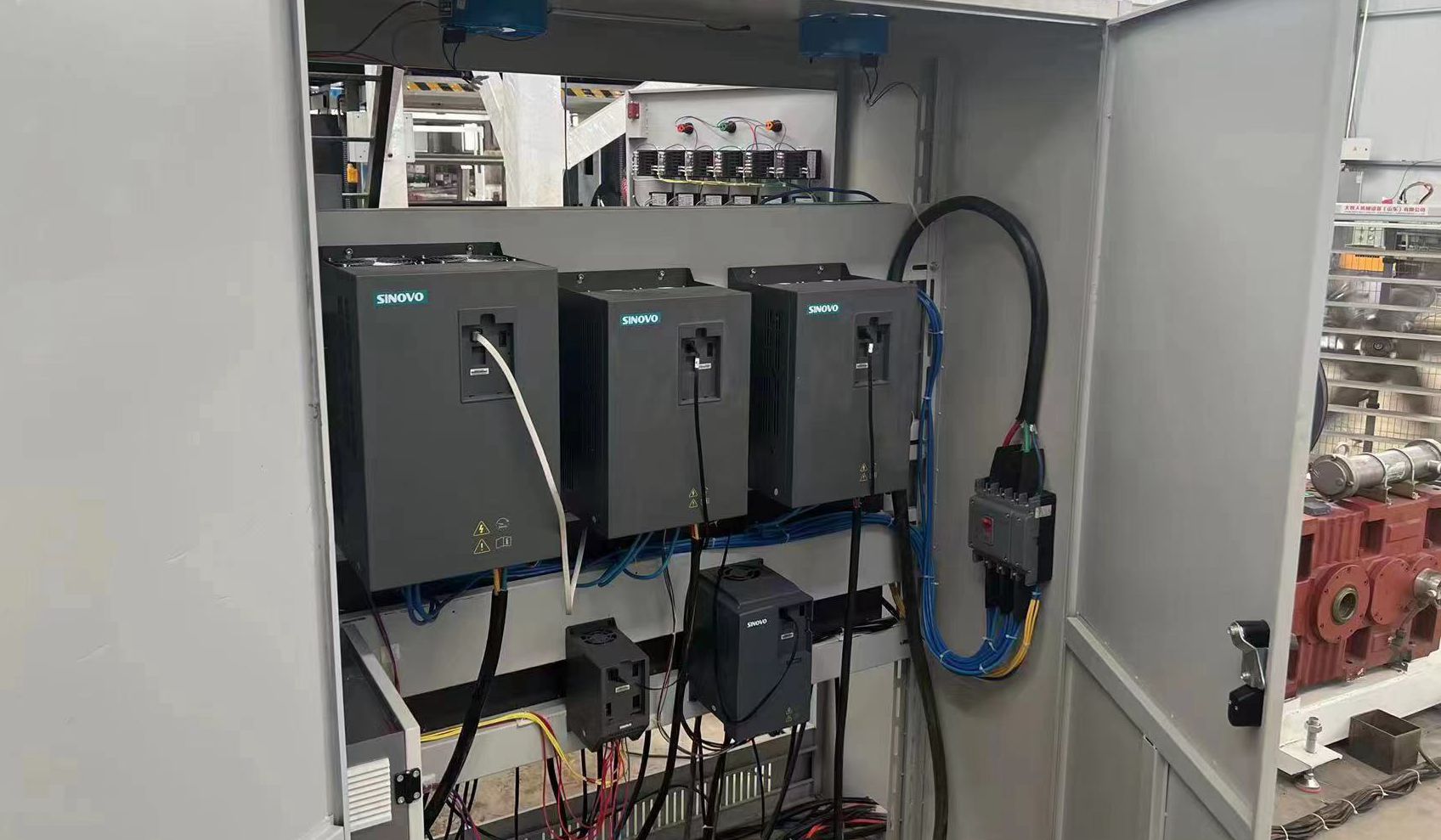At present, many small and medium-sized three-phase inverters adopt PWM control. Its carrier frequency is around several thousand to ten kilohertz, which causes the motor stator winding to withstand a high voltage rise rate, which is equivalent to applying a steep impact voltage to the motor, subjecting the motor’s inter-turn insulation to severe tests.
1. Motor efficiency and temperature rise.
Regardless of the frequency converter, whichever form it is, it will produce varying degrees of harmonic voltages and currents during operation, causing the motor to operate under non-sinusoidal voltages and currents. Although the data is introduced, for the currently widely used sine wave PWM type inverter, its low-order harmonics are basically zero, and the remaining high-order harmonic component is about twice the carrier frequency is 2u+1 (u is the modulation index ). High-order harmonics will cause an increase in stator copper loss, rotor copper (aluminum) loss, iron loss and additional loss, the most significant of which is rotor copper (aluminum) loss. Since the asynchronous motor rotates at a synchronous speed close to the fundamental frequency, the high-order harmonic voltage cuts the rotor bar at a large slip rate, resulting in large rotor losses. Additionally, additional copper depletion due to skin effects should be considered. These losses cause the motor to generate additional heat, reduce efficiency, and reduce output power. For example, when an ordinary three-phase asynchronous motor runs on a non-sinusoidal power supply output from a frequency converter, its temperature rise will generally increase by 10%-20%.
2. Motor insulation strength.
At present, many small and medium-sized inverters adopt PWM control. Its carrier frequency is around several thousand to ten kilohertz, which causes the motor stator winding to withstand a high voltage rise rate, which is equivalent to applying a steep impact voltage to the motor, subjecting the motor’s inter-turn insulation to severe tests. In addition, the rectangular chopper pulse voltage generated by the PWM inverter is superimposed on the motor’s operating voltage, which will threaten the motor’s ground insulation. The ground insulation will accelerate aging under repeated high-voltage impacts.

3. Harmonic electromagnetic noise and vibration.
Ordinary asynchronous motors use frequency converters, and the vibration and noise caused by electromagnetic, mechanical, ventilation and other factors will become more complicated. Each harmonic contained in the variable frequency power supply will interfere with the inherent spatial harmonics of the electromagnetic part of the motor, forming various electromagnetic excitation forces. When the frequency of the electromagnetic wave is consistent with or close to the natural vibration frequency of the motor body, resonance will occur, thereby increasing noise. Due to the wide operating frequency range and wide speed range of the motor, it is difficult to avoid the natural vibration frequency of each component of the motor.
4. The motor’s adaptability to frequent starting and braking.
Since the frequency converter is used for power supply, the motor can be started at very low frequency and voltage in non-impulse current mode, and the various braking modes provided by the frequency converter can be used for rapid braking, creating conditions for frequent starting and braking. Therefore, the mechanical system and electromagnetic system of the motor are under the action of cyclic alternating forces, which brings fatigue and accelerated aging problems to the mechanical structure and insulation structure.
5. Low speed cooling problem.
First, the impedance of the asynchronous motor is not ideal. When the power supply frequency is low, the losses caused by high-order harmonics in the power supply are greater. Secondly, when the speed of the ordinary asynchronous motor decreases again, the cooling air volume decreases in proportion to the cube of the speed, causing the low-speed cooling condition of the motor to worsen, the temperature rise to increase sharply, and it is difficult to achieve constant torque output.
At present, many small and medium-sized three-phase inverters adopt PWM control. Its carrier frequency is around several thousand to ten kilohertz, which causes the motor stator winding to withstand a high voltage rise rate, which is equivalent to applying a steep impact voltage to the motor, subjecting the motor’s inter-turn insulation to severe tests.
1. Motor efficiency and temperature rise.
Regardless of the frequency converter, whichever form it is, it will produce varying degrees of harmonic voltages and currents during operation, causing the motor to operate under non-sinusoidal voltages and currents. Although the data is introduced, for the currently widely used sine wave PWM type inverter, its low-order harmonics are basically zero, and the remaining high-order harmonic component is about twice the carrier frequency is 2u+1 (u is the modulation index ). High-order harmonics will cause an increase in stator copper loss, rotor copper (aluminum) loss, iron loss and additional loss, the most significant of which is rotor copper (aluminum) loss. Since the asynchronous motor rotates at a synchronous speed close to the fundamental frequency, the high-order harmonic voltage cuts the rotor bar at a large slip rate, resulting in large rotor losses. Additionally, additional copper depletion due to skin effects should be considered. These losses cause the motor to generate additional heat, reduce efficiency, and reduce output power. For example, when an ordinary three-phase asynchronous motor runs on a non-sinusoidal power supply output from a frequency converter, its temperature rise will generally increase by 10%-20%.
2. Motor insulation strength.
At present, many small and medium-sized inverters adopt PWM control. Its carrier frequency is around several thousand to ten kilohertz, which causes the motor stator winding to withstand a high voltage rise rate, which is equivalent to applying a steep impact voltage to the motor, subjecting the motor’s inter-turn insulation to severe tests. In addition, the rectangular chopper pulse voltage generated by the PWM inverter is superimposed on the motor’s operating voltage, which will threaten the motor’s ground insulation. The ground insulation will accelerate aging under repeated high-voltage impacts.

3. Harmonic electromagnetic noise and vibration.
Ordinary asynchronous motors use frequency converters, and the vibration and noise caused by electromagnetic, mechanical, ventilation and other factors will become more complicated. Each harmonic contained in the variable frequency power supply will interfere with the inherent spatial harmonics of the electromagnetic part of the motor, forming various electromagnetic excitation forces. When the frequency of the electromagnetic wave is consistent with or close to the natural vibration frequency of the motor body, resonance will occur, thereby increasing noise. Due to the wide operating frequency range and wide speed range of the motor, it is difficult to avoid the natural vibration frequency of each component of the motor.
4. The motor’s adaptability to frequent starting and braking.
Since the frequency converter is used for power supply, the motor can be started at very low frequency and voltage in non-impulse current mode, and the various braking modes provided by the frequency converter can be used for rapid braking, creating conditions for frequent starting and braking. Therefore, the mechanical system and electromagnetic system of the motor are under the action of cyclic alternating forces, which brings fatigue and accelerated aging problems to the mechanical structure and insulation structure.
5. Low speed cooling problem.
First, the impedance of the asynchronous motor is not ideal. When the power supply frequency is low, the losses caused by high-order harmonics in the power supply are greater. Secondly, when the speed of the ordinary asynchronous motor decreases again, the cooling air volume decreases in proportion to the cube of the speed, causing the low-speed cooling condition of the motor to worsen, the temperature rise to increase sharply, and it is difficult to achieve constant torque output.
continue reading
Related Posts
Variable Frequency Drives (VFDs) and motors are integral components in industrial automation, each serving distinct yet interconnected roles in controlling […]
Variable frequency motors (VFMs) are crucial in modern industrial applications due to their efficiency and precise control over motor speed […]
Variable Frequency Technology (VFT) is increasingly being recognized as a game-changer in the industrial automation sector, particularly in applications involving […]



